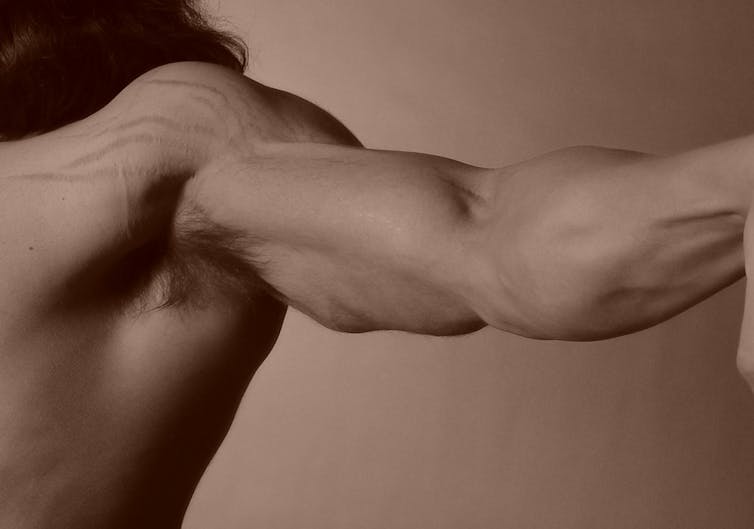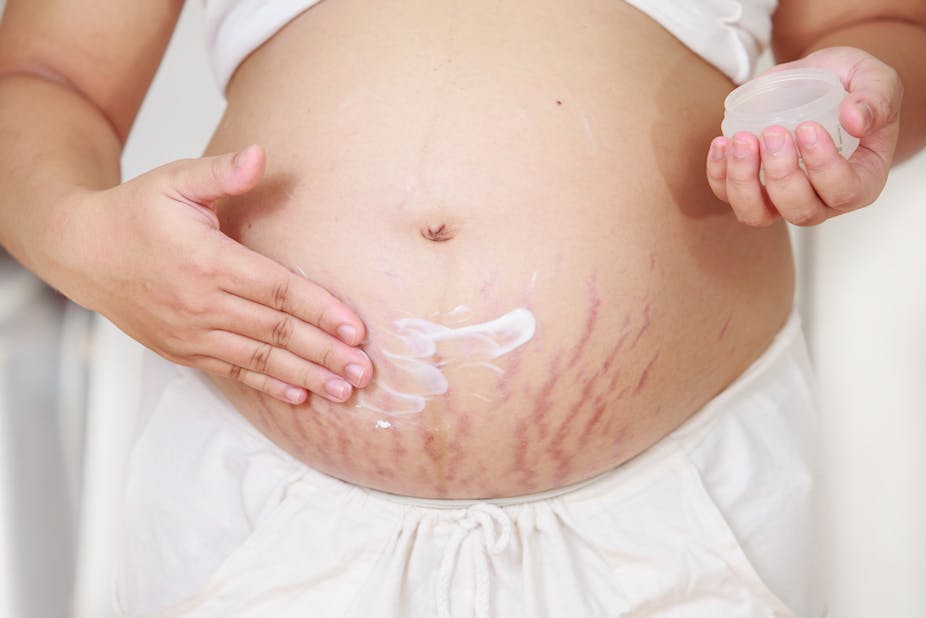Most women get them. Some men get them. Few people welcome them. Stretch marks, or stria distensae as they are known medically, are scars that appear when the skin is stretched beyond its elastic limit.
Physicists define the elastic limit as the maximum force that can be applied to solid material before the onset of permanent deformation. In dermatology, when stresses up to the elastic limit are removed, the skin resumes its original size and shape. When forces beyond the elastic limit are removed, the skin remains permanently stretch-marked.
The younger you are, the firmer your skin. The firmer your skin, the lower your elastic limit and the more likely you are to develop stretch marks. Stretch marks occur most frequently during adolescent or pregnancy growth.
The primary cause is mechanical stretching of the skin due to underlying tissue expansion. Parallel inflammatory streaks appear and align perpendicular to the direction of skin tension. Microscopically, the skin is initially swollen, inflamed and elastin bundles in the inner layer of skin (the dermis) are disrupted.
Over time, the inflammation eventually fades and is replaced by scar tissue. This produces a thinned outer layer of skin (the epidermis), loss of dermal elastin, and a replacement of the dermis by abnormally dense collagen fibres.
Risk factors
Adolescent stretch marks may appear on the lower abdomen, lower part of the back, buttocks, thighs and female breasts. They are most common on the thighs of girls and on the knees of boys.
Hormonal and genetic factors are also involved in the development of pregnancy stretch marks. Girls who develop adolescent stretch marks on their breasts are more likely to develop abdominal stretch marks during pregnancy. Younger women, women who gain more weight during pregnancy, women with twins or large babies and women who go post-term are all more likely to get stretch marks.
Weightlifters are more susceptible to stretch marks, especially those who use anabolic steroids. Stretch marks can also occur in Cushing’s syndrome or following the administration of oral and topical corticosteroids.

Prevention and treatment
Creams and lotions can’t prevent stretch marks. While not all preventative treatments have been evaluated, and some treatments have shown promise in individual studies, a Cochrane review in 2012 concluded there is:
no high-quality evidence to support the use of any of the topical preparations in the prevention of stretch marks during pregnancy.
People with stretch marks have four options:
1) Learn to love them: Embrace stretch marks. Show them off. Post them on social media. Wear them as a badge of honour.
2) Wait for them to fade: Most stretch marks begin red (stria rubra) and become white (stria alba) and less conspicuous over the course of a year or two. For people concerned by their stretch marks, reassurance is usually all that’s required.
3) Use creams to fade them: While creams won’t prevent stretch marks, they may help fade them, according to a recent comprehensive review.
Topical retinoid creams such as tretinoin are thought to work through induction of collagen synthesis and should be applied once daily for six months. Tretinoin works better on early red stretch marks, while white stretch marks respond poorly.
Skin irritation is a common side effect of tretinoin, so it may not be suitable for people with sensitive skin. Cocoa butter is less irritating, but also less effective. Newer silicone gels seem to be more effective.
4) Laser: While pulsed dye vascular lasers or intense pulse light (IPL) treatments can fade red stretch marks, this is unnecessary, as most will fade naturally within six to 12 months.
After a number of false starts, lasers have finally come of age for white stretch marks. The fractionated laser works by burning tiny pin-prick-sized holes in the skin. The wounds are not visible to the naked eye, but microscopic wound healing to repair these tiny holes promotes new collagen formation and improves the skin thickness and appearance of the stretch marks.
Responses vary but most people require four treatments, spaced four to six weeks apart, to achieve on average a 50% improvement. Inflammation is common after treatment and generally lasts 24 to 48 hours.
But for the vast majority of stretch marks, active treatment is not necessary. Most stretch marks naturally fade and become less conspicuous over time.

